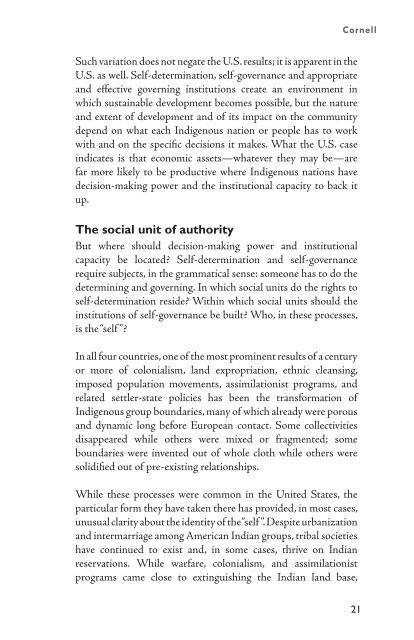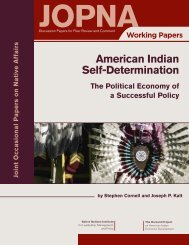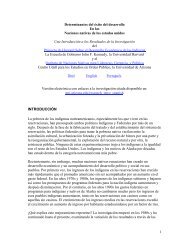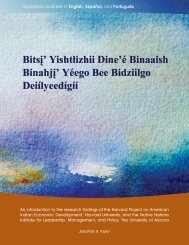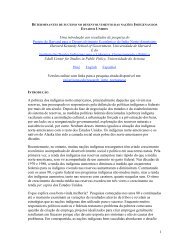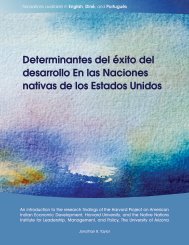Indigenous Peoples, Poverty, and Self-Determination in Australia ...
Indigenous Peoples, Poverty, and Self-Determination in Australia ...
Indigenous Peoples, Poverty, and Self-Determination in Australia ...
Create successful ePaper yourself
Turn your PDF publications into a flip-book with our unique Google optimized e-Paper software.
CornellSuch variation does not negate the U.S. results; it is apparent <strong>in</strong> theU.S. as well. <strong>Self</strong>-determ<strong>in</strong>ation, self-governance <strong>and</strong> appropriate<strong>and</strong> effective govern<strong>in</strong>g <strong>in</strong>stitutions create an environment <strong>in</strong>which susta<strong>in</strong>able development becomes possible, but the nature<strong>and</strong> extent of development <strong>and</strong> of its impact on the communitydepend on what each <strong>Indigenous</strong> nation or people has to workwith <strong>and</strong> on the specific decisions it makes. What the U.S. case<strong>in</strong>dicates is that economic assets—whatever they may be—arefar more likely to be productive where <strong>Indigenous</strong> nations havedecision-mak<strong>in</strong>g power <strong>and</strong> the <strong>in</strong>stitutional capacity to back itup.The social unit of authorityBut where should decision-mak<strong>in</strong>g power <strong>and</strong> <strong>in</strong>stitutionalcapacity be located? <strong>Self</strong>-determ<strong>in</strong>ation <strong>and</strong> self-governancerequire subjects, <strong>in</strong> the grammatical sense: someone has to do thedeterm<strong>in</strong><strong>in</strong>g <strong>and</strong> govern<strong>in</strong>g. In which social units do the rights toself-determ<strong>in</strong>ation reside? With<strong>in</strong> which social units should the<strong>in</strong>stitutions of self-governance be built? Who, <strong>in</strong> these processes,is the “self ”?In all four countries, one of the most prom<strong>in</strong>ent results of a centuryor more of colonialism, l<strong>and</strong> expropriation, ethnic cleans<strong>in</strong>g,imposed population movements, assimilationist programs, <strong>and</strong>related settler-state policies has been the transformation of<strong>Indigenous</strong> group boundaries, many of which already were porous<strong>and</strong> dynamic long before European contact. Some collectivitiesdisappeared while others were mixed or fragmented; someboundaries were <strong>in</strong>vented out of whole cloth while others weresolidified out of pre-exist<strong>in</strong>g relationships.While these processes were common <strong>in</strong> the United States, theparticular form they have taken there has provided, <strong>in</strong> most cases,unusual clarity about the identity of the “self ”. Despite urbanization<strong>and</strong> <strong>in</strong>termarriage among American Indian groups, tribal societieshave cont<strong>in</strong>ued to exist <strong>and</strong>, <strong>in</strong> some cases, thrive on Indianreservations. While warfare, colonialism, <strong>and</strong> assimilationistprograms came close to ext<strong>in</strong>guish<strong>in</strong>g the Indian l<strong>and</strong> base,21


